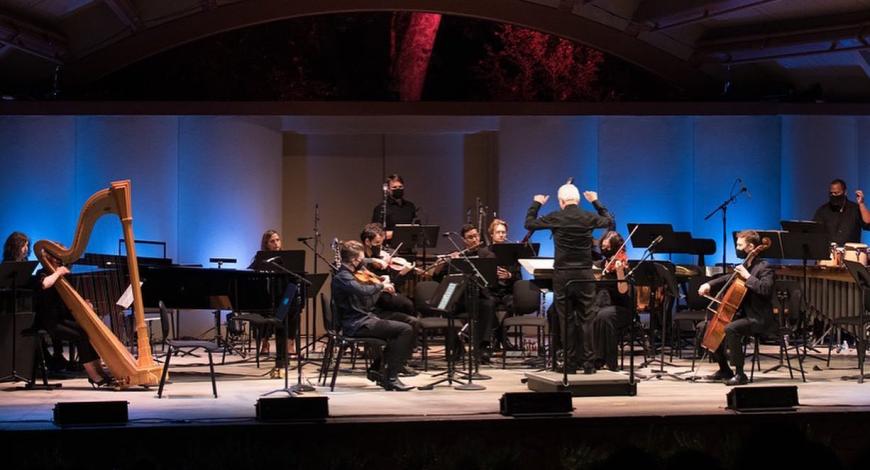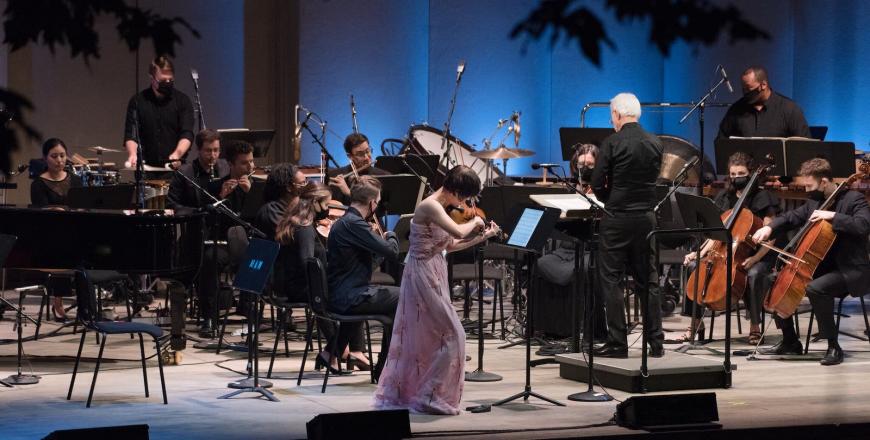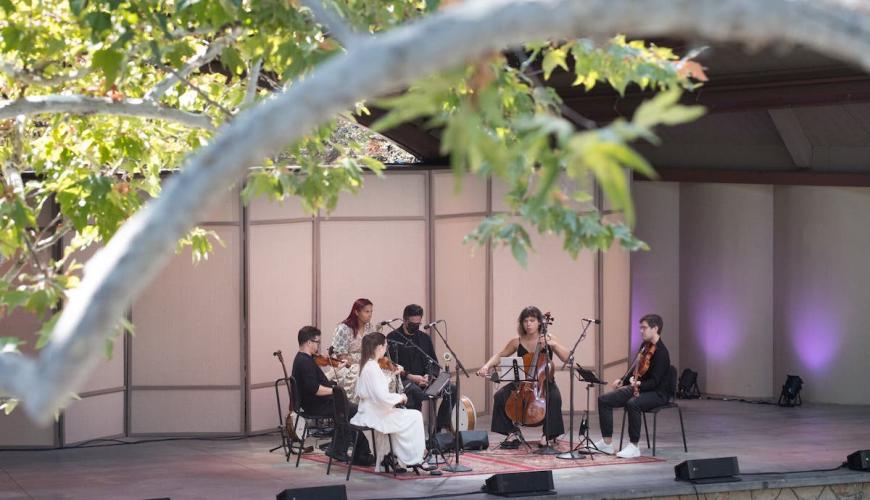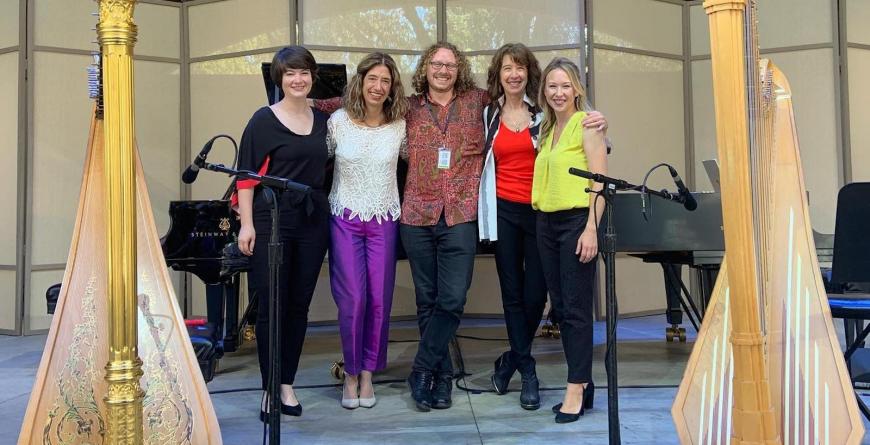
It’s difficult to gauge the degree to which the powerful impact of the latest Ojai Music Festival — returning after a pandemic-mandated two-year-and-three-month gap — had to do with absence making the heart grow fonder or the innate strengths of the programming and performances. No doubt, both factors were at work in this conscientiously homecoming-oriented long weekend in Ojai, Sept. 16–19.
Also adding to the heady and festive mix was the celebrated contemporary music-minded festival’s gala 75th year, and the eagerly awaited return of John Adams — also 75 — as music director. Adams last took that role in 1993 with a program highlighted by his then-new Chamber Symphony.
This year, in effect, he dodged the impulse to retrace Ojai’s storied past, instead generously spotlighting younger and attention-worthy composers. He also literally brought the family, extended and otherwise, with work by his well-established, now 37-year-old composer son Samuel, and proteges including festival standouts Gabriella Smith and Dylan Mattingly, and, on a parallel axis, pianist-composer Timo Andres.

Stravinsky, functioning as a kind of patron saint for the festival he directed in the early days and whose music is a staple here, showed up glancingly, but significantly: His brief Elegie for solo viola (Nathan Shram) opened Thursday’s concert, which Ojai’s new artistic director Ara Guzelimian explained was in honor of the many who were lost during the pandemic. Stravinsky’s miniature segued into a showcase for composers hereby dubbed the “Ojai Six” — festival-featured and formidable Mexican composer Gabriela Ortiz (with the virtuosic Huitzitl, for solo flute, here Emi Ferguson, strong despite the nattering car alarm in the distance), Smith, Mattingly, Samuel Adams, Andres, and Carlos Simon.
To these ears, the most dazzling composer was Smith (also mysterious by virtue of her absence, being presently hunkered down in Norway). Each of her pieces this weekend were riveting concert-closers: the rough-then-rigorous maze of the sextet piece Maré on Thursday, the bubbling cauldron of Carrot Revolution on the Attaca Quartet program (with its microtonal feint among other elements of surprise), and the fiendish solo piano workout Imaginary Pancake, closing Andres’s early Sunday morning recital. This music bristled with wit, free-ranging idiom-tapping, and restless invention: Smith’s is a fresh and refreshing musical voice in progress.

Although he was the festival’s de facto conductor of different ensembles, Papa Adams’s composer role was surprisingly downplayed and lacking recent works, as he let the limelight shine on the younger generation. We got a solid sense of the younger Adams’s musical voice via the West Coast premiere of his Chamber Concerto, with violin protagonist Miranda Cuckson enmeshing and tangling with the Ojai Festival Orchestra; his semi-Schubertian Impromptus in Andres’ solo recital; and his violin-piano duo Violin Diptych, lovely and tonal, but with liberties carefully taken (a strategy not unlike his father’s m.o.).
One unique factor in this year’s program was the inclusion of resident artist, MacArthur Grantee Rhiannon Giddens, possessing her own brand of genius, and a mission to explore roots (including her venerable black and North Carolinian roots) and on a mission to champion cultural systems of musical and racial parity. Other Ojai programs in recent times have delved into musical turf beyond standard brand “classical” or contemporary music quarters, including 2017’s Indo-jazz-new-music agenda directed by commanding keyboardist-composer Vijay Iyer, and maverick theater director Peter Sellars’s willfully eclectic mix and mash-up in 2016, both with uneven results.
Giddens, who studied at Oberlin before launching her specialized musical trajectory, was perfectly at home drawing a different type of audience for her Saturday night set with three musicians, including new multi-instrumentalist partner Francesco Turrisi, on bodhran and banjo. He was particularly adept as an accordionist, bursting out of drone duties for a few dazzling, jazz-tinged solos. Giddens showed her usual aplomb and versatility, along with an easy stage charisma. As is her wont, Giddens made the case for musical diversity, organically traversing vintage blues, traditional folk/bluegrass, Celtic music, and impressive original songs, capping it off with an apt “I Hear Music in the Air,” originally by the late, great Sister Rosetta Tharpe.

Some of the same material was cast in different contextual garb on her appearance in a concert featuring the fast-rising, Juilliard-born Attacca Quartet, with arrangements by Gabe Witcher and others. A question abuzz in Ojai, though, was how she would fare in operatic form, singing arias from Adams’s operatic oeuvre, from Doctor Atomic and I Was Looking at the Ceiling but Saw the Sky. If she appeared atypically nervous onstage during that final concert with Adams conducting the Los Angeles Chamber Orchestra, her vocal performance was luminous and true to form here. Might opera be yet another avenue for the curious Giddens? The prospect was at least validated in Ojai.
In the relatively youthful population of composers and performers, Esa-Pekka Salonen appeared as something of an eminence-gris-in-training. The mighty Finn plays a critical role in the serious musical culture of California, having led the LA Phil to global glory during his tenure as maestro (1992–2009), now embarking on his tenure leading the San Francisco Symphony, and having devised an especially juicy Ojai festival as director in 2001. (He was also slated to lead the 2018 festival, but scheduling conflicts led to a memorable substitution turn by Patricia Kopatchinskaya that year.)
Even with just two brief pieces on this year’s program, Salonen’s presence felt somehow central here. On the “premiere” front, his brief but intensive solo viola piece Objets Trouvés (Found objects), was lustrously played by Teng Li.
SoCal serious musical history was alluded to, obliquely, with Salonen’s Fog, dedicated to Disney Hall architect Frank Gehry, and the breathtaking venue itself — a symbol of L.A.’s qualitative flowering and worldly “arrival.” The “Ojai Festival Orchestra” fleshed out Salonen’s amicably muscular score, with its nods to Stravinsky and, yes, Adams.
That piece was preceded by violinist Miranda Cuckson, perched offstage, giving an excerpt from Bach’s Partita No. 3 in E Major. That was the piece played by LA Phil concertmaster Martin Chalifour when both Salonen and Gehry were nervously surveying the new hall’s acoustics. They approved. They wept. A Salonen composition/tribute was in order.
Another strategic Bach framing took place during Cuckson’s strikingly fine and innovative (and sometimes electroacoustic) Saturday afternoon recital at the Zalk Theater, as she played all movements of Bach’s famed D Minor Partita except the long, iconic Chaconne. Instead, she eased across epoch and genre into the semi-abstractionist sound world of Kaija Saariaho’s Frises.

Of special note among the younger composer crowd at Ojai 2021, Dylan Mattingly is a name and force to keep tabs on. He stated his poetic, almost mystical case on Thursday night and Sunday afternoon. In the former, the dynamic piano duo of L.A.-based new-music titans Vicki Ray and Joanne Pearce Martin (who also presided over the delicious sonorous hypnotism of John Adams’s Hallelujah Junction on Sunday), coaxed the proper detached lyricism of Mattingly’s Magnolia. It revels in echoes of Satie, but unhinged at the bar lines and other points of musical fixity.
High expectations greeted his world premiere, on commission from the Ojai Festival and the LA Phil, of his mesmerizing Sunt Lacrimae Rerum (These are the tears of things). Descriptions don’t do justice to this quirky music for two harps and two “detuned” pianos,” but the piece is a jewel of microtonal minimalism, with hints of Adams and La Monte Young and something personal. A recurring 14-note motive forges ever-forward and detours into an ethereal passage before reaching its transcendent climax, which was worthy of its standing ovation.
In Ojai, circa 2021, themes of “homecoming” and pandemic-related dynamics struck emotional chords beyond the provocative and consoling musical goods. Absence and vibrant presence made the heart fonder.
CORRECTION: As originally published this article misidentified Esa-Pekka Salonen's tenure as music director of the LA Phil.






